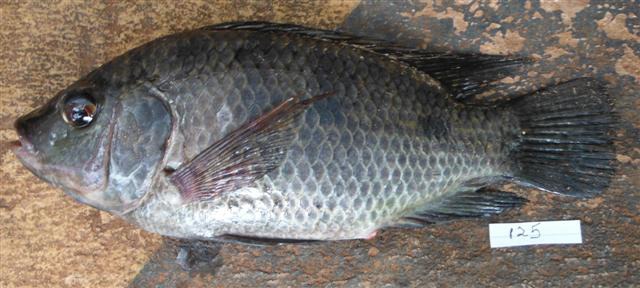| Cichlidae (Cichlids), subfamily: Pseudocrenilabrinae |
| 44 cm SL (male/unsexed) |
|
benthopelagic; freshwater; brackish; depth range - 1 m, |
| Africa: most of the Rufiji River and its tributaries, Kingani [= Ruvu] River, Mbwenkuru River and Wami River, all in Tanzania (Ref. 2, 118630, 118638). Populations in Zanzibar and Pemba may be native, although there may also have been some stocking from the mainland (Ref. 118638). |
|
Dorsal spines (total): 15-18; Dorsal soft rays (total): 11-14; Anal spines: 3-3; Anal soft rays: 9-12; Vertebrae: 29-30. Diagnosis: A large, deep-bodied species; mature males develop enlarged jaws and a concave head profile (Ref. 2, 118638). Other distinguishing characters of this species include: vertebrae 29-30; dorsal spines XV-XVIII, total dorsal rays 27-30, anal spines III; lower gill rakers 19-27; pharyngeal teeth slender, but firm, not crowded, blade of lower bone 0.9-1.25 times length of dentigerous area; and depth of caudal peduncle greater than its length (Ref. 2). Freshly collected males vary in colour: sometimes with grey head, brownish-golden upper parts, or sometimes with pinkish unpaired fins and upper parts; under stress, or after death, males tend towards uniform black body and fins, with reddish-pink dorsal and tail fin margins; females and immatures vary from light grey to dark brownish background, with dark flank patches and an anal fin with faint vertical bars (Ref. 2, 118638). |
| A maternal mouthbrooder (Ref. 118638); oviparous (Ref. 205). A large, fast-growing species heavily exploited in its native range (Ref. 118638). It was globally cultured in the past, making use of its salt tolerance and ability to produce all-male strains through hybridisation with Oreochromis niloticus and O. mossambicus (Ref. 118638). |
|
Least Concern (LC); Date assessed: 08 April 2021 Ref. (130435)
|
| harmless |
Source and more info: www.fishbase.org. For personal, classroom, and other internal use only. Not for publication.

